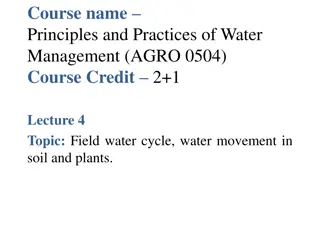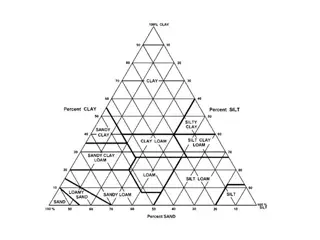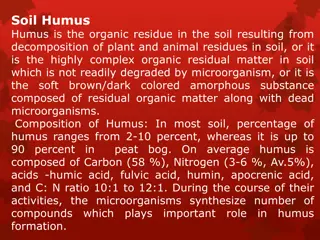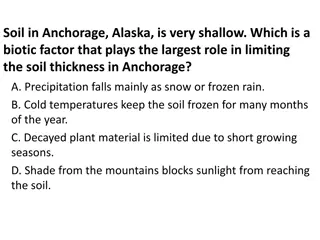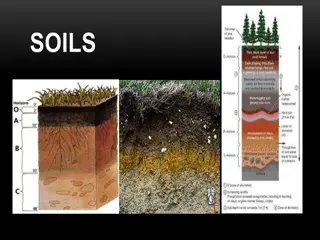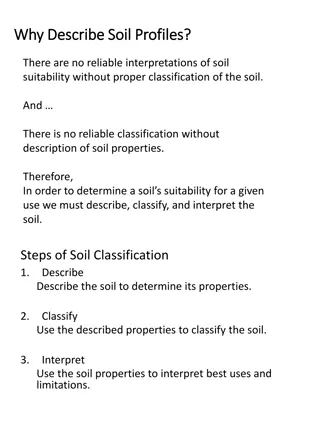Soil pH and Its Impacts
Soil pH refers to the negative logarithm of the hydronium concentration in the soil solution. It plays a crucial role in nutrient availability and affects the form in which nutrients are found in the soil. Soil pH levels can impact soil reactions, nutrient availability, and root health. Different types of soil acidity, such as active acidity and residual acidity, influence the overall health of the soil.
Download Presentation

Please find below an Image/Link to download the presentation.
The content on the website is provided AS IS for your information and personal use only. It may not be sold, licensed, or shared on other websites without obtaining consent from the author.If you encounter any issues during the download, it is possible that the publisher has removed the file from their server.
You are allowed to download the files provided on this website for personal or commercial use, subject to the condition that they are used lawfully. All files are the property of their respective owners.
The content on the website is provided AS IS for your information and personal use only. It may not be sold, licensed, or shared on other websites without obtaining consent from the author.
E N D
Presentation Transcript
Lab 3 Soil pH SOIL 4234
What is Soil pH? pH refers to the negative logarithm of the hydronium (H+) concentration in soil solution, relating to the OH- concentration pH = -log[H+] p is the log H is the concentration of H+ pH and pOH are interconnected Just like NaCl becomes Na+and Cl-when in solution, H2O will become H+and OH-when in solution For any solution at room temperature: pH + pOH = 14
What is Soil pH? Acidic solution H+> OH- Neutral Solution H+= OH- Basic Solution H+< OH-
What is Soil pH? pH = -log[H+] [H+] = 10-1 [H+] = 10-7 [H+] = 10-14 alkaline) pH = 1 (strong acid) pH = 7 (neutral) pH = 14 (strong
Effects on soil pH Soil pH can affect the reactions found within the soil Acids, specifically the H+that makes a solution acidic, can cause mayhem within compounds, stripping them of their components This not only affects nutrient availability, but also the form in which the nutrient is found in the soil
Types of Soil acidity As with nutrients (as lecture will discuss later), there are different types of soil acidity: Active acidity H+ions currently present in soil solution This is what is read using a pH meter, and governs all reactions, and causes problems with soil roots Residual acidity All acid cations tightly bound to soil minerals.
Types of Soil Acidity Exchangeable acidity Acid cations occupied on CEC Cation Exchange Capacity What we discuss as buffer capacity Buffer s must be used to measure this type of acidity Most common is Sikora Larger amounts of exchangeable acidity mean that in order to enact pH change via lime, more lime will be required compared to lower exchangeable acidity
Origins of Acidity Normal release of H+from natural chemical processes Atmospheric CO2and H2O react to form carbonic acid Organic molecules react with water and cause acid dissociation Oxidation of Nutrients Accumulation of O.M. Reaction of Al. cations with water Natural Deposition Lightning deposits acidic HNO3 Human Factors
Human Factors influencing soil pH Lime required to neutralize the soil acidity produced by fertilizers if all ammonium-N is converted to nitrate-N. Chemical Formula Lime required (lb CaCO3/ lb N) Long term application of acidifying fertilizers Nitrogen source Anhydrous ammonia Urea Urea-Ammonium Nitrate (UAN) Ammonium nitrate Ammonium sulfate Monoammonium phosphate Diammonium phosphate Triple super phosphate Composition NH3 82-0-0 1.8 Harvest of crops (NH2)2CO 46-0-0 1.8 (NH2)2CO, NH4NO3 28-0-0 1.8 Ca K Mg Na Total NH4NO3 34-0-0 1.8 Pounds ECCE Lime for a 30 bu/ac Wheat Crop 2 10 11 45 13 55 Grain Straw Total 10 14 24 2 9 24 79 (NH4)2SO4 21-0-0-24 5.4 NH4H2PO4 10-52-0 5.4 11 103 (NH4)2HPO4 18-46-0 3.6 P2O5 0-46-0 0.0 Adapted from Havlin et al., 1999.
Lime required to neutralize the soil acidity produced by fertilizers if all ammonium-N is converted to nitrate-N. Human Factors influencing soil pH Lime required (lb CaCO3/ lb N) Nitrogen source Anhydrous ammonia Urea Urea- Ammonium Nitrate (UAN) Ammonium nitrate Ammonium sulfate Monoammoni um phosphate Diammonium phosphate Triple super phosphate Chemical Formula Composition NH3 82-0-0 1.8 (NH2)2CO 46-0-0 1.8 Ammoniacal Fertilizer Plants must uptake N in the form of NO3- Molecules will become free ions, just as Na+and Cl-do when in solution (NH2)2CO, NH4NO3 28-0-0 1.8 NH4NO3 34-0-0 1.8 (NH4)2SO4 21-0-0-24 5.4 In order for NH4+to be converted to a usable form, oxidation must occur NH4H2PO4 10-52-0 5.4 Oxidation is the movement of electrons (NH4)2HPO4 18-46-0 3.6 P2O5 0-46-0 0.0 In this case, from the O2to the NH4 Adapted from Havlin et al., 1999.
How to measure soil pH? Using Glass electrode pH meter Compares voltage from electrode in sample to the electrode reading coming from a reference solution, and calculates pH Most of today s pH meters self contain both electrodes, however not all do Measures 2 types of acidity Based upon the extractor used
How to measure soil pH? 1:1 soil:water solution This gives you a read of solution acidity While important information, when it comes to lime recommendations, does not give an accurate portrayal of reserve acidity in the soil Sikora Buffer Utilizes a base to strip the exchangeable H+ions, those ions that contribute to CEC (as we ll talk about in another lab) pH is then read again using glass bulb electrode to give a measure of exchangeable acidity, or buffer


